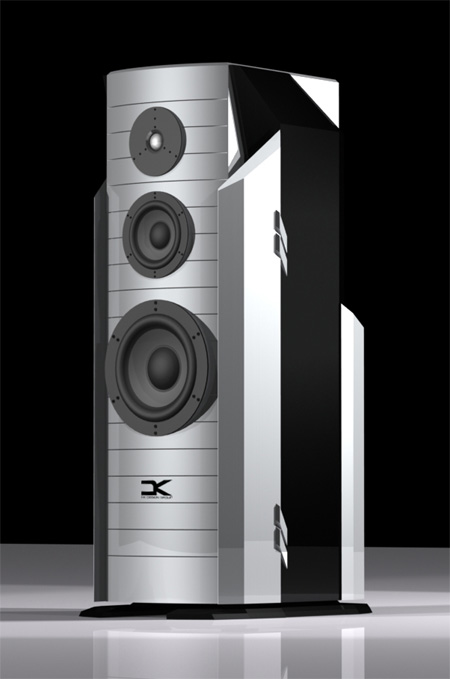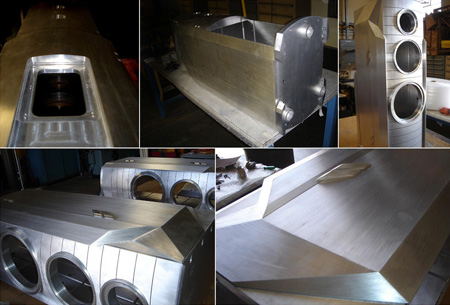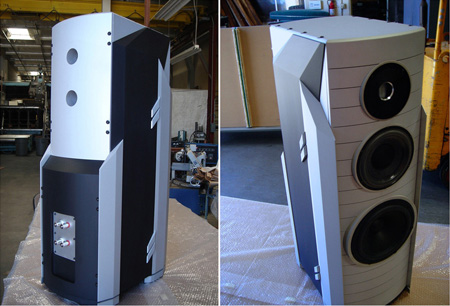You are reading the older HTML site
Positive Feedback
ISSUE
20
july/august
dk designs
X-Dream F7 loudspeakers
as reviewed by Jim Olson

|
JIM OLSON'S SYSTEM
LOUDSPEAKERS
ELECTRONICS
SOURCES
CABLES
ACCESSORIES |
DK Design Group is a new player on the audio scene, yet it has made a huge splash with the VS-1 Reference MK 2 integrated amplifier. Obviously, these guys know what they are doing, so when Daniel Khesin of DK told me about a new state-of-the-art speaker system under development for over a year, and graciously offered to let me review a pair, how could I refuse?
However, the review came with a major challenge. Each speaker, while rather small for a floorstander, weighs close to 400 pounds due to the use of some extremely complex materials and aircraft alloys in an attempt to completely eliminate enclosure resonance. Daniel and I agreed that it would be much more practical for me to pay a visit to the DK factory and do most of my evaluation there rather then trucking the loudspeakers to my apartment in New York. The DK Design Group factory is located in Newbury Park, California, and since I was planning a trip to California with my family, this worked out perfectly. I would spend a week at the factory evaluating the speakers, and DK Design Group would cover my expenses and provide me with a place to stay.
When I first walked into the DK facility, I was not prepared for what I saw. I thought that I had walked into a top secret NASA manufacturing facility, with workers walking around in space suits. It reminded me of a scene out of a James Bond movie, in which people were manufacturing something that could potentially take over the world. The 24-hour temperature-controlled facility is about 10,000 square feet, and is fitted with incredibly advanced CNC machines. All of the machines are laser calibrated and linked through a PC network. There is a 24-station automatic tool changer with a Fanuc 11M controller, also laser calibrated. All of these machines are necessary to machine the complex materials used in the X-Dream F7s. We are talking about a level of precision that is simply unheard of in the audio industry.
When it comes to design, certain examples have achieved historical status in every field. In architecture, the Eiffel Tower, the Empire State Building, and the Guggenheim Museum have everlasting beauty. In automobile design, it's the Mercedes Gulwing, the Lamborghini Diablo, the Ferrari Enzo. In chair design, it's the Herman Miller Aeron, the Barcelona Chair, and so on. In audio, however, there are few outstanding examples, and well-designed components receive practically no recognition outside the pages of Stereophile. Quality is usually defined as thick walls, good finish, great sound, with aesthetic design secondary at best. Enter the X-Dream F7s.
An innovative designer must have talent and inspiration, as it is all too easy to fall into the grooves cut by predecessors. Speakers are particularly difficult because of their functional limitations. Designing a speaker that seamlessly blends into any interior yet makes a statement is an art in itself. Aside from a couple of computer-rendered images that aroused my interest in this revolutionary product, I had no idea what to expect when I arrived at the DK factory. When I walked into the rather small room that had been provided for my listening session, I recognized the F7s standing in the back, but was surprised by their size. I expected them to be at least my height, but I was wrong—the F7s are only 37 inches tall. Their intricate shape and two-tone color scheme create an amazing visual harmony that is no less impressive than a Ferrari under a summer sun.
I knew that these speakers were 95 percent constructed of aircraft-grade aluminum, and that each one approached the weight of an upright piano, but I thought that their size could not possibly warrant such weight. Wrong again. When I tried to push one to make it lean, I was unable to move it. I tried with both hands and managed to tilt it about a centimeter, but this was only possible because the speaker was sitting on three spikes. I was awestruck—the F7s reminded me of the Rolex Perpetual Oyster, a watch that is also machined from a billet of aluminum. Each speaker consists of an aluminum chassis complemented by three side panels with complex curves. Unlike most speakers, which only look good from certain angles, the F7s looked fantastic from all angles. The F7s will appeal to audiophiles who like a massive yet elegant feel—no wood here, ladies. Their finish is absolutely impeccable, and their precision of assembly is the kind you would expect from an overfunded military project.

Some cutting-edge thinking went into these loudspeakers. They employ 48-dB-per-octave, low-Q Bethel transitional filters with an eighth-order elliptical transfer function response. This means that the crossover network allows for maximum damping and eliminates ringing as well as signal distortion. Of course, a filter this advanced requires very sophisticated engineering and extraordinary mathematical complexity. Eighth-order elliptical filters are normally not achievable with passive crossovers, and are usually found in the electronics used in digital signal processing. Daniel Khesin explained that most manufacturers promote the 6-dB first-order network as the most phase-coherent, but it is the most popular because it is the easiest to execute. Anyone with a little engineering knowledge can whip up a 6-dB crossover, as there are only a handful of variables involved, but the first-order crossover has many problems, including significant driver overlap and vertical polar tilt, which produces a small sweet spot.
The other benefit of a low-Q filter is that the group delay graph shows no sudden change. An underdamped filter will produce a big spike in group delay. A fast rate of phase change can cause phase distortion, which results in smearing and lack of detail. The X-Dream group delay curves are relatively stable and uniform. The crossover employed also features a conjugate network that eliminates the electrical resonance of each driver and damps out the sealed-box resonance of the midrange driver. The crossover network is assembled from the highest quality materials, such as high-voltage silver foil capacitors, high-gauge air-core inductors, and the finest metal film resistors. All connections are made with high-purity silver solder, and the connection to the amplifier is made via the highest-grade silver-plated WBT binding posts.
Finally, since each cabinet has over 350 pounds of aircraft aluminum in a relatively small 36-inch enclosure, the X-Dream is truly the last word in resonance control. Even half this amount of metal would have resulted in the most non-resonant enclosure in the industry. Aluminum has an amazing stiffness-to-mass ratio and very low energy storage. The cabinet releases energy in the form of heat. The X-Dream F7 represents a fanatical dedication to manufacturing the best possible loudspeaker. This is not just another wooden cabinet with woofers. It is a completely re-thinking of loudspeaker design, and significantly advances the loudspeaker designer's art.

I had what I can only describe as multiple out-of-body experiences during my listening sessions with the X-Dream F7s. It was as if I had been taken to the Amazonian jungle, smoked some hallucinogenic plants with the local shamans, and had been transported to another reality. After I had taken a comfortable seat in the listening position, Daniel Khesin spent about fifteen minutes talking about the technology employed in the X-Dreams before playing any music. Then he put the Burmester CD sampler in the Mark Levinson transport and pressed Play. (The rest of the system consisted of a modified BAT VK-30 preamp, a Pass Labs X350 amplifier, and Cardas cable.) After my initial shock had subsided, I realized that I was hearing the most faithful reproduction of recorded music that I had ever experienced. Time absolutely stopped, and the experience was nearly orgasmic. Everything sounded extraordinarily real. The music had an organic feel, a sense of continuity and wholeness, a complete coherency, perfect pitch definition, perfect solidity, shocking transients, explosive dynamics, and a soundstage that swept the room. I thought I was hallucinating!
Every recording was an absolute revelation. From the lowest frequencies to beyond the limit of my hearing, the sound was completely seamless, with a pitch-black background. Music leaped out from a black void with an amazing vibrancy, then slowly decayed into the ether. It was as if the waveform was more densely packed with information. The continuity and wholeness somewhat reminded me of the legendary $90,000 Audio Note Ongaku amplifier, but the X-Dreams exhibited an extraordinary slam and dynamics that could only be characteristic of Mark Levinson 33H monoblocks.
There was such a complete lack of coloration that I realized just how much distortion even the very best loudspeakers suffer from. Usually, speakers have a warmth in the midbass that, according to Daniel Khesin, is caused by microscopic vibration in the cabinet that is transferred to the drivers. The enclosure acts like a giant low-frequency driver, generating a very low-output tone that is audible, and generates what many of us mistakenly believe is warmth. The X-Dreams had a completely different presentation in the midbass region, and it was eye-opening. There was an inner glow, a natural warmth of real instruments, a gentle flow of energy. It was simply uncanny, but it was not the kind of warmth that you hear from most loudspeakers. As confirmed by accelerometer readings, the X-Dream cabinets simply have no measurable resonance, vibration, or energy storage—none, zilch, nada. These cabinets approach the theoretical ideal.
I am very fit, work out often, and eat a low-fat diet, but let me tell you, the dynamics of the X-Dream F7s almost gave me a heart attack! The Chinese percussion on track ten of the Burmester sampler was reproduced with pacemaker-stopping realism and impact. Sounds started and stopped with razor-sharp precision. When a drum whack stopped, there were no trailing edges or any other sounds. It stopped suddenly. As crazy as this sounds, this made me (temporarily) think that I would rather listen to these loudspeakers then live music. Okay, maybe not, but I did think about it.
Whenever possible, I like to make A/B comparisons with other products. In this case, any comparison was simply futile. I mean no offense to other manufacturers, but no other loudspeakers could even come close to this level of performance. The X-Dreams should be renamed the Wet Dreams, and will please audiophiles in ways they've never dreamed possible. I have to say that the X-Dream F7 loudspeaker system is the best that there is, the best that there ever was, and I suspect the best that there will ever be. It is the most impressive audio component I have ever experienced, and gets my vote for product of the decade.
In an industry flooded with copy cat products, many people will roll their eyes at another $25,000 loudspeaker, but not this one. Taking into account that the X-Dream F7s are constructed of over 700 pounds of high-grade aluminum, employ the very best drivers sourced from Danish suppliers, have the very finest crossover components, and require high-precision machining, anodizing, and finishing, not to mention the fact that it takes approximately three months to machine just one cabinet, the X-Dreams are a terrific value before they play a note. Since they are also the most faithful reproducers of music I know, the X-Dream F7s qualify as the steal of the century. Jim Olson
X-Dream F7 loudspeakers
Retail: $25,000 a pair
DK Designs
web address:
www.dkdesigngroup.com
